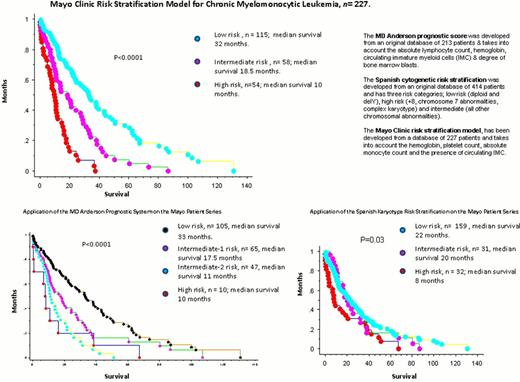Abstract
Abstract 3790
Chronic myelomonocytic leukemia (CMML) is a clonal stem cell disorder characterized by: persistent peripheral blood (PB) monocytosis (>1 × 10(9)/L), absence of BCR-ABL1 fusion, absence of rearrangement of the PDGFRA/B genes, <20% bone marrow (BM) & PB blasts, and dysplasia involving one or more myeloid cell lines. It is clinically considered to be an overlapping syndrome with myelodysplastic and myeloproliferative features. The natural history and prognostic features of CMML are not well defined with the MD Anderson prognostic score (MDAPS) and the Spanish risk stratification by cytogenetics being the two major prognostic tools currently being used in clinical practice.
227 patients with WHO defined CMML were seen at the Mayo Clinic from 1997 through 2007. All patients underwent bone marrow (BM) examination and cytogenetic evaluation at diagnosis. We evaluated the prognostic relevance of several clinical and laboratory parameters including those previously identified by the MDAPS (Blood 2002;99:840) and the Spanish cytogenetic risk stratification (Haematologica 2011;96:375).
Among the 227 study patients, 153 (67%) were males and median age was 71 years (range, 17–90 years). There were 192 (85%) patients with CMML-1 & the remainder had CMML-2. At a median follow-up of 15 months, 166 (73%) deaths and 33 (14.5%) leukemic transformations were documented. Median survivals were 22 months for CMML-1 and 14 months for CMML-2. In univariate analysis, significant risk factors for survival included decreased hemoglobin level, decreased platelet count and increased levels of white blood cells (WBC), absolute neutrophils (ANC), absolute monocytes (AMC), absolute lymphocytes (ALC), PB blasts, BM blasts and presence of circulating immature myeloid cells (IMC; inclusive of PB blasts). However, on multivariable analysis that included the aforementioned Spanish cytogenetic risk stratification, only increased AMC (>10 × 10(9)/L, RR 2.5, 95% CI 1.7–3.8), presence of circulating IMC (RR 2.0, 95% CI 1.4–2.7), decreased hemoglobin (<10 g/dL; RR 1.6, 99% CI 1.2–2.2), and decreased platelet count (<100 × 10(9)/L; RR 1.4, 99% CI 1.0–1.9) retained significance. Using these four independent risk factors, we prepared a new prognostic risk model that performed better than both the MDAPS and the Spanish cytogenetic risk models (Figure). The Mayo risk model was also predictive of leukemic transformation: high risk RR 4.9 (95% CI 1.9–12.8) and intermediate risk RR 2.6 (1.1–5.9). Individual parameters of independent significance for leukemic transformation included PB blast count and AMC >10 × 10(9)/L.
Absolute monocyte count is the strongest predictor of survival in CMML. Other independent risk factors include circulating immature myeloid cells, anemia and thrombocytopenia. A risk model based on these four risk factors is effective in predicting both overall and leukemia-free survival and outperforms both the MDAPS and risk stratification by cytogenetics.
No relevant conflicts of interest to declare.
Author notes
Asterisk with author names denotes non-ASH members.


This feature is available to Subscribers Only
Sign In or Create an Account Close Modal